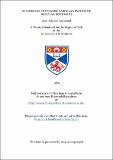Files in this item
Studies on the water vascular system of regular echinoids
Item metadata
| dc.contributor.advisor | Laverack, M. S. | |
| dc.contributor.author | Raymond, Alan Michael | |
| dc.coverage.spatial | 1 vol. | en_US |
| dc.date.accessioned | 2018-06-25T14:32:31Z | |
| dc.date.available | 2018-06-25T14:32:31Z | |
| dc.date.issued | 1979 | |
| dc.identifier.uri | https://hdl.handle.net/10023/14551 | |
| dc.description.abstract | The water vascular system is a highly modified mesocoel which is unique to the phylum Echinodermata. Hypotheses for the evolution of the water vascular system and its relationship to the mesocoel of other oligomerous animals are discussed. A scanning electron microscope survey of the skeletal structures associated with the water vascular system provides the first description of the ultrastructure of the madreporite, terminal tube foot plate, peristomial tube foot plate, tube foot (peri-stomial and ambulacral) disk elements. The relationship between the structure and function of skeletal elements is discussed, with particular emphasis on the madreporite and differences between the pores and disk elements of ambulacral and peristomial tube feet. The fine structure and innervation of the following intrathecal regions of the water vascular system were investigated: madreporite, axial organ, stone canal, circumoesophageal and radial water canals. It is postulated that the water vascular system has an important role in the transport, processing and removal of amoebocytes. The Polian vesicles and axial organ are major sites for amoebocyte collection and the axial organ processes amoebocytes prior to their removal via the madreporite. It is proposed that the madreporite is an excretory structure and necrotic amoebocytes and waste materials are evacuated by the ciliary activity of the endothelial cells lining the madreporite canal. On the basis of ultrastructure and fluorescence histochemistry, it is postulated that the aminergic axons of the basiepithelial plexus have a cilio-effector role and thus respiratory currents generated by ciliated epithelial cells are under neuronal control. The fine structure and innervation of the tube foot/ampulla complex was investigated. The three muscle groups of the complex consist of the disk levator muscle (D.L.M.), stem retractor muscles (S.R.M.) and ampulla muscles. It is proposed that the D.L.M. and ampulla muscles are structurally/functionally distinct from the S.R.M. with respect to endurance, speed of contraction and range. It is also proposed that the "changing acting partners" model for molluscan smooth muscle can also be applied to echinoderms' smooth muscle. The innervation of the tube foot/ampulla complex is rather unusual and it is proposed that a tube foot/ampulla ganglion occurs at the base of the tube foot within the perradial pore. Modified muscle processes termed muscle tails pass into the perradial pore and are innervated by motoneurons within the tube foot/ampulla ganglion. In addition, peripheral neurons termed L.D.S.G. cells innervated S.R.M., D.L.M., and connective tissue of tube feet and the inner muscle layer and connective tissue of the axial organ and Polian vesicles. The L.D.S.G. cells have been characterised histochemically and cytochemically and it is proposed that they elaborate a glycoprotein which has an important role in regulating cation fluxes within the connective tissue and musculature. The histochemistry and cytochemistry of tube foot connective tissue was investigated and the relationship between collagen filaments and glycoproteins and glycosaminoglycans are described. | en_US |
| dc.language.iso | en | en_US |
| dc.publisher | University of St Andrews | |
| dc.subject.lcc | QL384.E2R2 | en |
| dc.subject.lcsh | Sea urchins | en |
| dc.title | Studies on the water vascular system of regular echinoids | en_US |
| dc.type | Thesis | en_US |
| dc.contributor.sponsor | Science Research Council (Great Britain) | en_US |
| dc.type.qualificationlevel | Doctoral | en_US |
| dc.type.qualificationname | PhD Doctor of Philosophy | en_US |
| dc.publisher.institution | The University of St Andrews | en_US |
This item appears in the following Collection(s)
Items in the St Andrews Research Repository are protected by copyright, with all rights reserved, unless otherwise indicated.

